
21 minute read
An ode to the “search” and “find” commands on our computers
NOSH TOWN by Claudia Schou
SUMMER’S ALL-AMERICAN (PANDEMIC) COOKOUT
Summer is officially underway, so what better way to celebrate the season than to embrace the summer tradition of backyard grilling with family and friends? A cookout is the perfect way to practice social distancing with loved ones while satiating your gustatory appetites. Whether you’re in the mood for burgers, marinated meats, grilled tofu and veggies, it’s time to fire up the grill. Over the coming weeks, Montecito Journal will run a series of articles featuring culinary experts and businesses that we hope will inspire your grilling adventures all summer long.
ANTHONY ENDY EXECUTIVE CHEF AT ALISAL GUEST RANCH
Though he’s been executive chef and full-time pit master at Alisal Guest Ranch & Resort for two years, Anthony Endy, a Santa Ynez Valley native and former corporate chef at Paul Martin’s American Grill, has already earned a reputation for sophisticated Coastal Ranch-style barbecue, cooked over an open fire and charred to perfection. Endy’s slow-cooked-to-perfection approach to mouthwatering barbecue draws aficionados near and far to the ranch for a seasonal BBQ Bootcamp, where guests learn techniques such as spice blending and smoking meat to grilling desserts and lighting a fire over an open pit. We asked Endy to share some of his summer grilling tips with our readers.

Favorite BBQ tool?
A good pair of tongs is always essential. There are a lot of gadgets out there but stick to the basics.
What is your BBQ flair?
I cook Bold California BBQ. I not only have a fresh approach to Santa Maria-style, local oak wood fires in open pits, but I also slow smoke and grill with fresh ingredients. I honor tradition and promote innovation to the cuisine that surrounds the fire.
What are you listening to when you’re grilling?
Blues: Muddy Waters; Country: Eric Church; Americana: Ryan Bingham; Rock: Gary Carter Jr.; Hip Hop: anything from the ‘90s – Juicy, The Notorious B.I.G.
LOMPOC VALLEY PINQUITO BEANS
INGREDIENTS 1 lb. dry pinquito beans, see sources below Water to cover beans 2 cups Applewood smoked bacon, diced 1/2 cup smoked cooked ham, diced 1 cup white onion, diced 1/2 cup roasted Anaheim chilies, diced 2 tbsp. garlic, minced 1 tsp. ancho chile powder, optional 1 tsp. brown sugar 1 tsp. salt 1 tsp. dry mustard 1 tsp. paprika 2 cups tomato puree 1 cup Worcestershire sauce 1/2 cup water
Q. What is your meat or seafood choice at the moment? Rinse and check through the beans for small stones. Place the beans in a pot and cover A. I have so many, but right now I’m focusing on my roots with Tri-Tip. Growing up here on with cold water and soak overnight. Drain the beans and return to the pot. Cover the the Central Coast, Tri-Tip has always been an integral cut of beef to grill over an oak fire. beans with fresh, cold water by three inches and simmer over medium heat for 1.5 hours, Be sure and always buy high quality beef, for Tri-Tip I like to stick to Prime Angus or Wagyu or until tender. breeds. While the beans are cooking, make the sauce. Over medium high heat, sauté bacon in a saucepan over medium heat until lightly browned. Add the ham, onion, Anaheim What is your favorite go-to summer marinade? chilies, and garlic and sauté two minutes longer. Add the ancho chile powder, brown During summer I like bright acidic and fresh marinades with a touch a spice. You can’t go sugar, salt, dry mustard, and paprika and sauté for another minute to toast the spices. wrong with a classic chimichurri. You will need fresh herbs (cilantro, parsley, oregano) along Add the tomato puree, Worcestershire sauce, and water. Bring the mixture to a simmer with fresh garlic, lemon juice, white balsamic vinegar, olive oil, and chiles (I like fresh Fresno and reduce to low heat and cook for 30 minutes while stirring occasionally. Remove from chiles or dried chile de arbol). In a blender, puree all the ingredients with salt and pepper heat and reserve. to taste to bring the marinade together. This marinade is very simple to make yet packs a When beans are cooked tender, drain all except for one cup of the cooking liquid. flavorful punch that can be added to pretty much everything – meats, vegetables, or used Return the beans and cup of liquid to the pot and stir in the sauce. Simmer on low heat as a sauce on seafood. for 30 minutes. Where to find Central Coast grown pinquito beans: Lompoc Beans, Lompoc Valley Seed What is your favorite herb and seasoning for grilled fish? & Milling 805.736.2517; lompocbeans.com •MJ It really depends on the fish and my mood of the day. I generally like a fresh piece of white flaky fish simply prepared with sea salt, fresh lemon, extra virgin olive oil and touch of oregano and dried chile de arbol. I also love a classic Cajun blackening spice that toasts over a high TASTING NOTES WITH SANTA BARBARA WINE heat fire (great for a seared tuna) finished with extra virgin olive oil. COLLECTIVE MANAGER WYATT DAVIDSON What are your favorite summer side dishes? Wow that’s like going to your favorite steakhouse and choosing one side. I love Lompoc S anta Ynez Valley’s Storm Wines has been making some of the most elegant wines in Santa Barbara County since as early as 2006. Ernst Valley Pinquito Beans braised with bacon, onion, garlic, green chiles, ancho chile powder, Storm grew up in South Africa, where he studied winemaking and lager, Worcestershire sauce, beef stock, and BBQ trimmings. You also can never go wrong worked in both the Stellenbosch and Walker Bay regions. He settled in with creamed corn, I add grilled poblano chilies to mine to give a needed smoky spice balSanta Barbara County to explore the cooler growing areas and to focus ance to the sweetness. on Pinot Noir and Sauvignon Blanc from sites that embody elegance and show personality in their vintage. And the climate is not unlike the What is your favorite condiment? Western Cape, where his curiosity for winemaking began. My favorite goes in hand with the marinade – a classic chimichurri. I also don’t mind a good Storm’s passion for wines with character shines through his 2019 BBQ sauce – yes I said that. There is a time and place for a sweet, spicy sauce that is not too Storm Sauvignon Blanc. The fruit for this Sauvignon Blanc was thick. I do at times crave a Roasted Tomato Salsa with a steak, a combination of flavors that sourced from six vineyards at different corners of Santa Ynez Valley. speaks to my youth here in the Santa Ynez Valley. Tropical notes and grapefruit dominate the nose that leads you to a palate filled with refreshing citrus, guava, melon, and a long delicious What are you grilling for dessert? finish. Crisp and refreshing, this Sauvignon Blanc is a personal favorite Right now I am loving the peaches from Buttonwood Farms that are in season. They are for a warm summer day at the Santa Barbara Wine Collective, alonggreat on the grill served with grilled pound cake and freshly whipped vanilla bean whipped side a house-made cheese board and a freshly sliced baguette from cream. And I’m a chocolate guy that also loves mezcal sticky toffee pudding off the grill. This our sister company, Helena Avenue Bakery. Or pick up a bottle to-go dish speaks volumes to when great products handled correctly and executed simply over the and enjoy at home with dinner. I love to enjoy mine with local Santa grill can be spectacular. Barbara sea bass and grilled vegetables. •MJ 42 MONTECITO JOURNAL “If you have a secret, people will sit a little bit closer.” – Rob Cordry 9 – 16 July 2020
WATER WISDOM (Continued from page 22) a reluctant Montecito Sanitary District (MSD) Board for a joint recycled water rationing restrictions, drilled private water wells to avoid the loss of millions of agreement that met the legal restrictions wherein MWD would be the distribudollars invested in green landscaping. The number of new wells is unknown, tor and seller of recycled water while Montecito Sanitary (MSD) would be the but the 550 known producing wells, plus an estimated 730 permitted, unperproducer of higher-quality recycled water. mitted, and abandoned wells, had the unintended consequence of sticking hun dreds of new straws into Montecito’s shrinking, low-level aquifers. Year 2017: Santa Barbara Goes It Alone
Large well users who deserted MWD, were careful to retain MWD meters In May 2017, startup testing at the Santa Barbara desalination plant was comfor low-volume household water, while still holding the option to pick up the pleted and the City started distributing 3,125 AFY of desalinated water into the telephone and demand more MWD water for their precious landscaping any City’s water system. 3,125 AF of water represents about 30 percent of the City’s time the underlying water table, or their wells, went to mud from overuse. water demand of 11,000 AFY. Desalinated water joined surface water from the Meanwhile, they contributed nearly nothing to maintaining the increasingly Cachuma and Gibraltar reservoirs, groundwater, State Water, imported water, expensive fixed costs of the State Water System, or to providing water to protect recycled water and conservation in a balanced City water-supply portfolio. our community from repeated wildfires. Just as important, the City was permitted by the State and the Coastal The Year 2015: Renewed Interest in City Desal Commission to add an additional 4,375 AF of desal capacity at a lower cost at any time it chose, simply by adding additional membrane trains. That provides
Battered by Board decisions to impose rationing, and after futile efforts to the cushion to service Montecito’s 1,430 AFY requirements when the City runs design and build their own desal plant in Montecito, a pair of former MWD low on its available water supplies. Directors, both trial lawyers, approached the City in 2015 to explore a partnerThe capital costs to reactivate the desal facility were $72 million, more than ship deal for desal water. These two talented lawyers descended on the City twice the cost of the original plant in 1991. The $72 million cost was financed Water team, largely composed of engineers, and immediately fell into the legal over 20 years with a low 1.6 percent interest rate state loan, which equates to quagmire of who would bear what liabilities. $4.2 million per year in debt service. In 2018, the City was awarded a $10 million
City negotiators, whose #1 priority was to craft a jointly-agreed-to term sheet, grant from the Department of Water Resources, which, if accepted by the City argued that legal points could be negotiated later, once a business deal was in Council, significantly reduces the overall cost of the project. place. A Memorandum of Understanding was delivered by the City to MWD Annual operating costs are estimated at about $4.1 million at full production on September 22, 2015 stating that “time was of the essence and it was necessary to and about $1.5 million in non-operation or standby mode. The plant could be conclude development of an Agreement by January 1, 2016.” put in standby mode during certain periods to reduce operating costs, but the
In October 2015, after months of haggling, the City delivered a Preliminary WSA requires the desal plant to remain in a condition capable of producing Term Sheet to MWD with instructions to respond by December 31 to move water within 10 days. negotiations forward. The plant design includes a screened ocean intake structure, using wedge
With some rainfall and a prediction of a wet Winter-Spring, MWD General wire screens made of durable copper-nickel alloy with one-millimeter openings Manager Tom Mosby, at the direction of his Board, stalled negotiations with the to minimize marine life entrapment and impingement; diluted and diffused City. His December 31, 2015 response cited a “need for more studies and a need brine discharge; and high-efficiency pumps and motors to reduce the plant’s for more financial consultants.” His letter concluded “Best wishes to all in 2016 overall electrical power demands. and may ample rainfall fill our reservoirs (and cups) this winter.” Desal Deal Resuscitated. Montecito Wants Back in The Game The Year 2016: It was not until the election of Floyd Wicks to the MWD Board in December A Year of Stalled Negotiations with the City Over Desal of 2016 that talks with the City could safely resume. Wicks, a respected and seasoned water executive, was able to approach the City with the skills and
Rebecca Bjork, City Public Works Director, responded to Mosby on January mindset of an engineer to restart the lengthy negotiations that led to a prelimi19, 2016 noting that, “We seem far apart on many issues, including the basic structure nary agreement, and now final approval. for the sale of water to the District quantity of water it needs.” … The District has been unable to even identify the The Advantage of Ownership The City mandated that talks with Montecito could not begin again until City negotiator Josh Haggmark and his team have crafted a beautiful MWD paid upfront, non-refundable fees of $528,000 in order to start renegotiAgreement for the City, not simply to recover modest costs of adding new ations without wasting City time or City costs. The first payment of $193,594 desal trains to serve Montecito’s water needs, but rather to recover 46 percent was delivered to the City in September 2016 to restart negotiations. Restart of all the hard and soft costs incurred by the City since 1992, including all legal, payments included a portion of the costs for the City’s Carollo Engineering permitting, design, construction, operations, maintenance, chemicals, supplies studies, IDE desal design costs, legal costs, permitting costs, hydraulic modelfor the plant, plus 65 percent of the cost of the City’s conveyance pipeline to ing, conveyance pipeline design and City staff administrative costs. In addition, transfer water from the desal plant on the coast to the Cater Water Treatment MWD spent approximately $615,000 in consulting fees, legal fees and staff time Plant north of the Santa Barbara Mission. to explore its own desal plant in fiscal 2015-2016. The price of water is based on the theory that the City is supplying Montecito The Year 2016: Changes in Water Leadership with 1,430 AFY out of its current production of 3,125 AFY of desal water, which computes to 46 percent of all desal costs charged to Montecito. The source
In February 2016, Water District Manager Nick Turner replaced retiring genof water supplied to MWD is totally at the City’s discretion but will always eral manager Mosby. In December 2016, current MWD president Floyd Wicks, include a portion of desal. a water engineer and industry veteran, and Tobe Plough, a business consultant, were elected as new directors to replace appointed Director Charles Newman The Desal Deal is Done… An Historic Regional Partnership and retiring Director Jan Abel. In March 2018, the MWD Board voted to support restarting negotiations with
Two years later, in 2018, three additional new directors – the financially savvy the City. Two months later, in May 2018, the City Council authorized its water Ken Coates, the politically savvy Cori Hayman, and the business-savvy Brian staff to execute a new Funding Agreement with MWD and resume negotiations. Goebel – joined the MWD Board, completing the change from cozy, appointed In January 2019 the Santa Barbara City Council and the MWD Board directors to elected directors responsible to customers. approved a Term Sheet and directed staff to draft a Water Supply Agreement The Year 2017: What Changed with the New MWD Board? (WSA) with MWD. The time to act, not yak, arrived. On June 23, 2020, the MWD Board unani
First off, at the insistence of newly elected Water Directors Floyd Wicks and mously approved the WSA with the City. Seven days later, the Santa Barbara Tobe Plough in early 2017, the District wrote and adopted its long neglected, City Council voted unanimously to ship 1,430 AFY from the City’s drinking state-required, 2015 Urban Water Management Plan (UWMP). The District water supply to Montecito every year for the next 50 years, rain or shine. That committed in writing to the State that it would set a goal of increasing local, represents 40 percent of Montecito-Summerland current needs. drought-proof water supplies to 85 percent of total supplies by the year 2025. In return, the Montecito Water District has agreed to effectively fund 46 perAdditionally, because the previous Board had neglected to file the mandatory cent, or $33 million, of the City’s $72 million desalination plant through 2072, State Urban Management Plan in either 2010 or 2015, MWD found itself out of plus interest and a share of operation and maintenance costs, unless the plant compliance with State mandates and therefore ineligible for state water grants. is expanded. Contract signing is expected in July or August 2020. First water
The new UWMP established new water priorities: (1) negotiation of a longdeliveries will begin January 1, 2022. term water supply agreement with the City of Santa Barbara; (2) exploration Regional partnerships bring communities closer together. Let’s hope that of groundwater banking opportunities, and (3) pursuit of an agreement with works for this Water Supply Agreement after 32 years in the making. •MJ 9 – 16 July 2020 • The Voice of the Village • MONTECITO JOURNAL 43
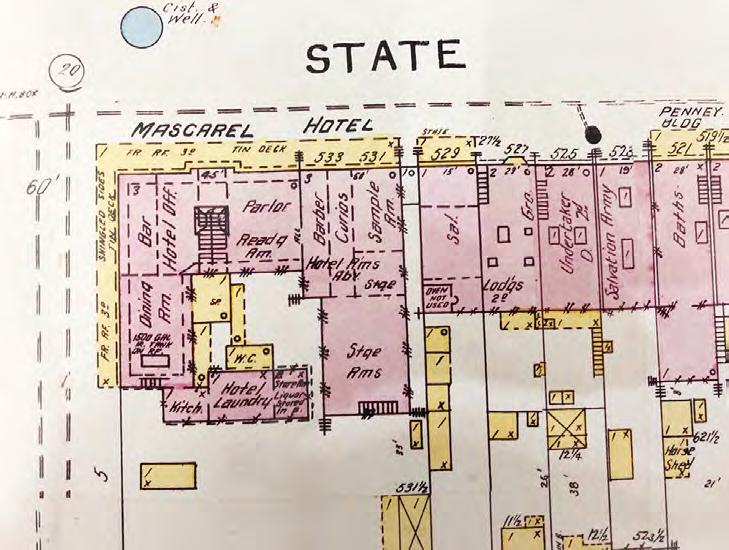
The Occidental Hotel where Jerry set up the first bootblack stand in town (Courtesy Santa Barbara Historical Museum)
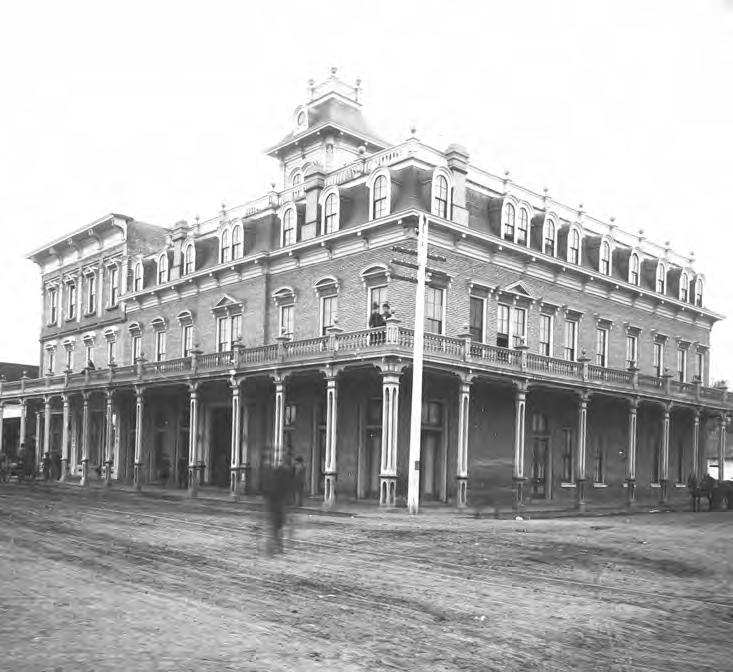
was in town to play at Lobero’s Opera House, several members joined Jerry to give an outdoor, free entertainment in front of the Occidental Hotel in the afternoon. “Quite a crowd gathered to listen to the old time negro melodies by the entire company; and to witness the dancing of ‘Jaba’ by Prof. Forney, which was done in his usual artistic style.” Forney’s Colony Plan
In 1881, Jerry’s entrepreneurial nature took a different turn, one that was reported as far away as Sacramento. “Jerry Forney, a colored man at Santa Barbara, is arranging an exodus of colored people from his old home in North Carolina.”
Locally, the Press reported, “Mention was made in these columns sometime since, of a plan of Jerry Forney to induce a number of colored people to emigrate here from North Carolina… A paper setting forth that a limited number of colored people, who would be willing to work for reasonable compensation, has been circulated by Jerry, and has received upwards of five hundred signatures, who number among them our best and wealthiest people.
“Forney has opened a correspondence with an old acquaintance of his, and by the latter is informed that a colored colony of good mechanics, farm laborers, and house servants could easily be formed to come here, if their passage money be sent them. Jerry is confident he will succeed in his undertaking.”
To understand Jerry’s motivation in taking on this project at this time, one needs to remember that the Compromise of 1877 resulted in the beginning of the “Long Night” of racial segregation and subjugation. A disputed election between the party of Lincoln (Republicans) and their candidate Rutherford B. Hayes, and the party of the South (Democrats), who wanted Samuel J. Tilden, led to
Showing a little slice of State Street in 1903, the Sanborn Fire Insurance map shows the layout of the Mascarel (formerly Occidental, formerly Commericial) Hotel, where Jerry lodged in staff quarters for a time (Courtesy Santa Barbara Historical Museum) the terrible betrayal. The Democrats would agree to the election of Hayes if the North would remove its troops from the South. These troops had been stationed in the South to ensure that Reconstruction policies and programs that helped the former slaves were secure. Southerners, of course, promised to treat the freedmen fairly, but step by step, African Americans were denied the right to vote and segregation took hold. Violence against those who objected became common.
It is difficult to know how many African American families came to Santa Barbara at this time, but his scheme must have been somewhat successful, for as late as 1886, he was placing ads in the Morning Press such as the following: “A colored man and his wife want situations. No objections to going into the country. Apply to Jerry Forney, next to the Commercial Hotel.”
Jerry’s was not the only colonization plan at this time. As the situation for African Americans in the South deteriorated and the need for laborers in the West rose, colonies were estab
lished in California in such places as 44 MONTECITO JOURNAL
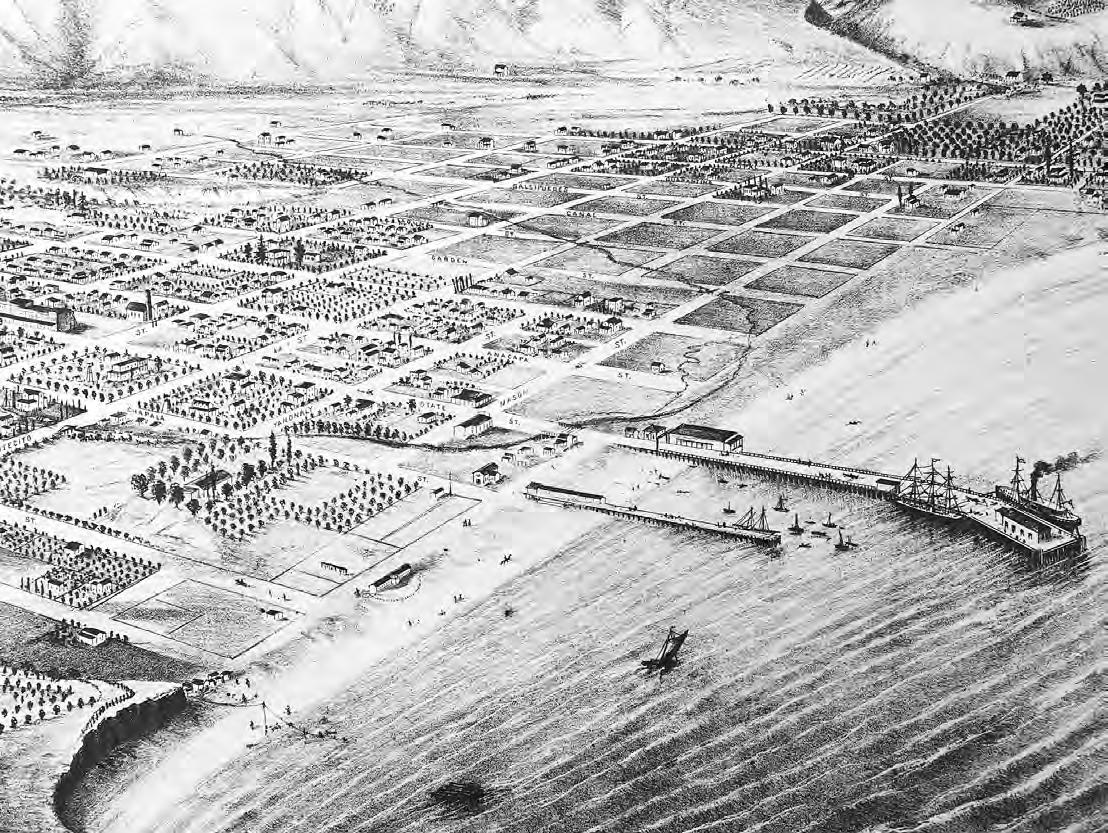
State Street with the Hotel Mascarel (former Occidental Hotel) on the left. Santa Barbara had dirt streets, a tram system, and was building wooden sidewalks when Jerry moved to town. (Courtesy Santa Barbara Historical Museum)
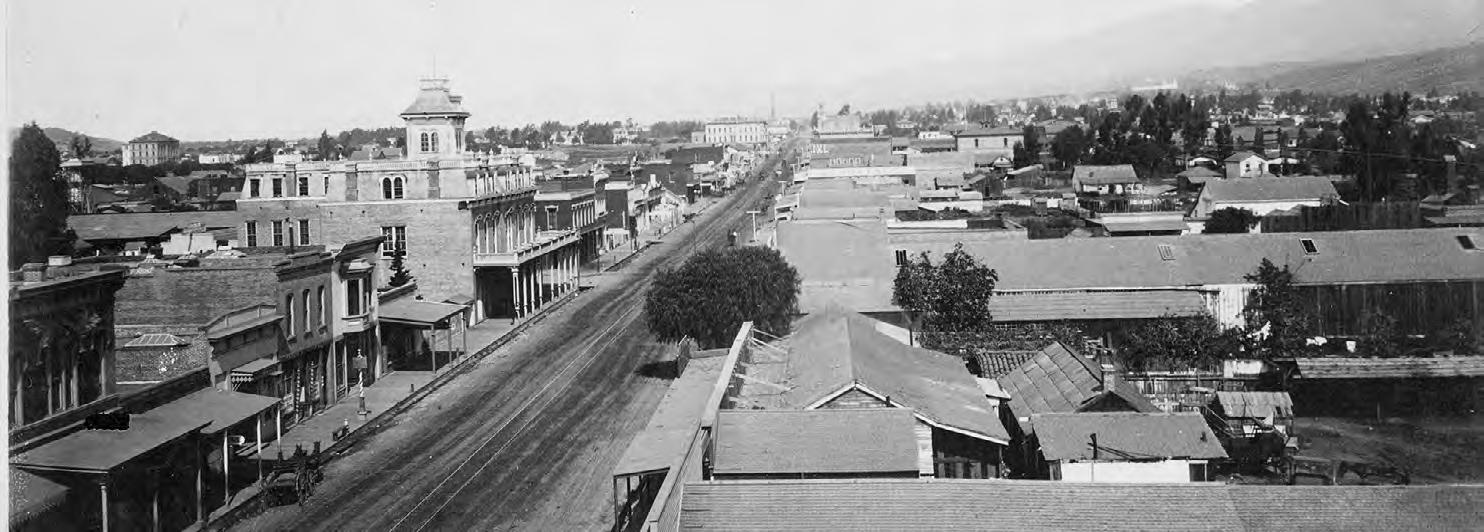
Drawing of the tableau scene of “Tenting on the Old Camp Ground” (San Francisco Examiner, 1897)

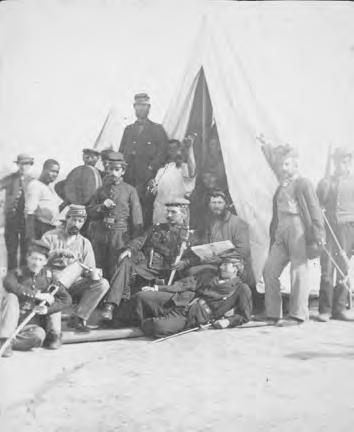
A photo from the Civil War shows a New York regiment posing with both black and white members. Notice the soldier with a rifle on the far right. (Library of Congress)
Shasta County and Fresno (1887 and 1888), and the A.M.E. in Los Angeles was involved in planning a colony in Lerdo, Sonora, Mexico, in 1891.
Jerry
Jerry’s activities were constantly in the news. He acted on the Lobero stage when a traveling production of Uncle Tom’s Cabin came to town in 1881. That year he also participated in the annual multi-day Flower Carnival held at the Lobero Theatre. The Morning Press reported, “The most interesting feature of all, will probably be the exnouncement’ of the temperance principles of Jerry Forney.” Jerry also agreed to sing some songs from his former Carolina home.
When Major R.H. Hendershot, the heroic drummer boy of the Rappahannock, came to town, Jerry Forney participated in the closing tableau. It was entitled “Tenting on the Old Camp Ground” and showed a group of soldiers employed in their usual occupations while the famous song was sung. The audience was delighted to see Jerry on the stage. A 9 – 16 July 2020 haunting, beautiful rendition of the song that laments the tragedy and terrible losses for both sides during Civil War can be found at https://www. youtube.com/watch?v=bI67rO2zdC4
Jerry also immersed himself in the horticultural life of the community. He was experimenting with growing cotton and solicited the members of the Santa Barbara County Horticultural Society to experiment as well by giving them seeds. Jerry’s garden supplied his friends with clusters of fine large tomatoes and strawberries. The Morning Press reported, “Jerry has a typical southern garden and says he can raise the same things here as he did back there, though tomatoes the first of January are not common even in the South.” In 1891, he joined all the top horticulturalists in the area, like Kellogg, Cooper, Stow and Sexton, by sending an entry to the Agricultural Fair in Los Angeles. His was a cotton plant.
In 1885, Jerry, now about 64 years old, married 35-year-old Martha Harris. The two eventually moved to a house at 33 North Yanonali Street (today a parking lot on the southwest corner of Yanonali and Anacapa streets) and lived out their lives there. Martha worked at a laundry. In 1886, Jerry announced himself a candidate for mayor for the second time. Though he didn’t win, Jerry was not finished with politics; in 1890, he was on the ballot to be a delegate at the Republican primary.
In 1898, Jerry suffered a paralytic stroke and became crippled by his rheumatism. He was no longer able to work. They relied on Martha’s small earnings for their support and the generosity of his many friends. In 1903, Pio Calderon, a fellow bootblack who had learned his trade from Jerry, held a benefit for Jerry and Martha. He announced that the total receipts for that day would go to them.
In February 1904, Jeremiah A. Forney was summoned to meet his maker. He was nearly 90 years old. Despite its hardships, his was a life well lived. His influence on others of his race, his energy and spirit, his admirable amiability toward all people and his varied passions and interests made him a person who stood out from the rest. He would be missed.
R.H. Hendershot was the heroic drummer boy of the Rappahannock who enlisted at age 11. He came to Santa Barbara which a show that included a drumming performance and Jerry participated in the final tableau. (Library of Congress)
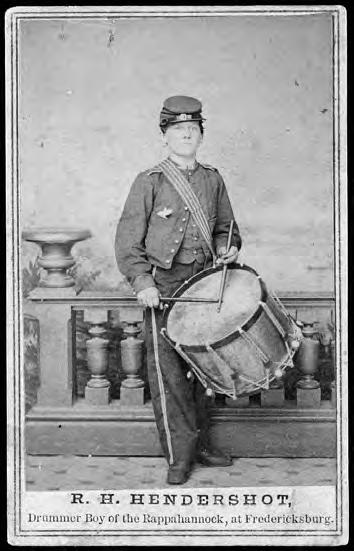
Though Jerry never had children, by 1908, there was another Forney family living in town. Their origins were Burke County, North Carolina. Their descendents live and work in Santa Barbara today, and many were members of the St. Paul African Methodist Episcopal Church, which has recently been nominated to become a historic landmark. (More on that next time.) •MJ
(Sources: Contemporary newspapers, City Directories, US. Census, Marriage Registry, Voter Registration Records; Ione city websites; Morganton, NC websites; Biographical History of North Carolina from Colonial Times to Present, edited by Ashe and Weeks, 1905; various websites on Bellevue and Forney plantations; “Slavery in Microcosm: Burke County, North Carolina” by Edward W. Phifer in The Journal of Southern History, Vol 28, No. 2 (May 1962), pp 137-165) MONTECITO JOURNAL 45










